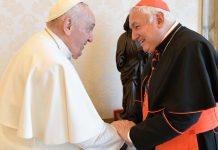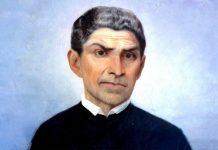St. Louis-Marie Grignion explained, developed and encouraged, in his writings, a special deepening of devotion to the Holy Mother of the Creator, taken to the extreme of slavery and complete abandonment of oneself to her maternal care.
Newsroom (03/05/2023 18:00, Gaudium Press), Louis-Marie Grignion, the second child of Jean-Baptiste Grignion and Jeanne Robert, was born in Montfort-sur-Meu on 31 January 1673.
As the cradle was chosen and prepared by Providence for the Saint’s birth, de Montfort became a perennial symbol of a supernatural reality which the life and gestation of this man of God made explicit to humanity: a special deepening in devotion to the Holy Mother of the Creator, brought to the extreme of slavery and complete abandonment of oneself to her maternal care.
To understand the extent of this surrender, St. Louis Grignion needed to make of his existence an intimate, prolonged and loving meditation on Our Lady, so that the Most High would teach him a secret that he could never find in ancient books or those of his contemporaries.
It is the Secret of Mary, the mystery of a profound relationship with the Mother of God, which, at the end of his life, St. Louis transcribed in the ‘Treatise on True Devotion to the Blessed Virgin’, bringing together the teachings that will form, until the end of time, the authentic servants of the Queen of the Universe.
Let us follow, in a few lines, this life of meditation that prepared the drafting of the Treatise.
Entertaining Mary
When only twelve years old, Louis was sent by his parents to study at Saint-Thomas Becket College in Rennes, where he stayed with his uncle Alain Robert, a priest of the Saint-Sauveur parish.
Contrary to the customs of his peers, as a teenager he tried to make recollection his frequent occupation, preferably at the feet of some statue of the Madonna in the surrounding churches, thus avoiding the affairs of the world around him.
From 1695, at which time he was a postulant in the seminary of Saint-Sulpice, the young man’s soul soared ever higher, like an eagle soaring high above the clouds to contemplate more fully the almost infinite splendours of the Morning Star. Our Lady was the only panorama that this eagle was pleased to admire. Any entertainment from which the names of Jesus and Mary were absent was insipid and disgusting to him.
In those years, he did not lack excellent readings which solidified in his soul the principles inspired by grace, such as Henri-Marie Boudon’s ‘Dieu Seul: Le saint esclavage de l’admirable Mère de Dieu’ (‘God Alone: The Holy Slavery of the Admirable Mother of God’), and the Psalter of the Virgin attributed to St. Bonaventure. It was while still in the seminary that the Saint decided to found the association of the Slaves of Mary in order to propagate the doctrine of holy slavery, the distinctive sign of his ministerial apostolate.
However, what makes us understand more clearly the intensity of his relationship with the Lady of the Angels are the little-known moments when She came to live with and personally communicate her maternal designs to the apostle She had chosen.
On one occasion, a man entered the sacristy to go to confession and found the missionary, already at the end of his days, conversing with a Lady of indescribable purity. As if in apology for the inconvenience, he received the kind explanation: “My friend, I am amused by Mary, my good Mother”. Were such miraculous interviews with the Queen of the Universe commonplace for St. Louis? Judging by the naturalness of his reply, everything indicates that they were.
Recollected at La Rochelle
In the autumn of 1712, in the tranquil city of La Rochelle, in the hermitage of St. Elias, St. Louis Grignion decided to write down the doctrine that he had been teaching fruitfully for many years, in public and in private, on his missions.
The redaction was relatively quick, the result of an enormous remote preparation: abundant readings, familiar conversations with the holiest and wisest personages of his time, incessant preaching, ardent prayers over decades.
The hatred of hell
It happens in salvation history that every holy work, bearing good fruit, is inevitably hated and opposed by the serpent’s race. Thus, the writing of St. Louis also became the target of the infernal forces, as, moreover, the Saint had prophesied would happen, in an impressively accurate manner:
“I foresee that frenzied beasts will rush in with fury to tear with their diabolical teeth this little writing and the one whom the Holy Spirit made use of to write it, or at least to envelop it in the darkness and silence of a vault, so that it will not appear at all. They will even attack and persecute those who read it and put it into practice”.
In fact, during the French Revolution, the manuscript was locked in a box and hidden in Saint-Laurent-sur-Sèrvre, in a field near the chapel dedicated to St. Michael the Archangel. Once the storm of the Revolution had passed, it remained forgotten there until 29 April 1842, when a missionary of the Society of Mary found it among other old books.
After the discovery, there were some hesitations about certain corrections made, which did not seem to be by the author, besides several pages that had mysteriously disappeared.
Originally, the work consisted of nineteen notebooks, of which the first seven were lost. Of the eighth, only ten pages remain, and of the last, only six. For this reason no one knows the real name of the Treatise. It is supposed that it is most probably ‘Preparation for the Kingdom of Jesus Christ’ because St. Louis calls it so in the manuscript. As for the actual title, it was given to the work when the first edition was printed.
However, neither the lost title, nor even the almost one hundred pages that have disappeared, prevent it from working in souls the conversions that the Virgin so much awaits, for the Treatise is the bearer of graces that teaches hearts with even greater acuteness than the words contained in it instruct the minds.
Rescued from the shadows and placed on the candelabrum, the new Marian doctrine contained in these few pages began to spread throughout the world, and the number of the slaves of Mary multiplied and continues to spread in the twenty-first century.
Now, what new and powerful doctrine is this, feared by hell to the point of trying by all means to make it disappear?
In search of the most precious pearl
Slavery. There is no such thing as a lower condition. But “there is nothing among Christians that makes us belong more absolutely to Jesus Christ and his most holy Mother than voluntary slavery, according to the example of Jesus Christ himself, who for love of us took the form of a slave – formam servi accipiens – and of the Blessed Virgin, who declared herself the handmaid and slave of the Lord.”
To cling to the hands of Our Lady is, as the Saint amply argues, the shortest, most efficacious, perfect and secure way to unite ourselves fully with Our Lord Jesus Christ; that is, to consummate the spiritual life and to attain sanctity.
Now, following St. Louis’ recommendations to the letter, we shall see that devotion to Mary, taken to the extreme, requires a surrender to Her of all that one possesses, whether in the order of nature or of grace, in the most radical way, as he himself strongly recommends:
“If you have found the treasure hidden in Mary’s field, the precious pearl of the Gospel, you must sell everything to buy it; you must make a sacrifice of yourself into Mary’s hands, and joyfully lose yourself in Her to find God alone there.”
Once possessed of this priceless pearl, what can the human soul desire more than to have it, even in the beatific vision?
This is a clause which fortunately appears in the essential words of the formula composed by St. Louis:
“I surrender and consecrate to you, as a slave, my body and soul, my interior and exterior goods, and even the value of my past, present and future good works, leaving you the full and entire right to dispose of me and all that belongs to me, without exception, at your pleasure, for the greater glory of God, in time and eternity.”
Such a complete surrender to a pure creature – Mother of God and Queen of Heaven and earth, no doubt, but merely human – could not fail to raise opposition, which was also already foreseen by the St. Louis de Montfort:
“If any critic, on reading this, should judge that I speak exaggeratedly and from excessive devotion, woe to him, for he does not understand me, either because he is a carnal man, who does not appreciate at all the things of the spirit, or because he is of the world, who cannot receive the Holy Spirit, or because he is proud and critical, who condemns and despises what he does not understand. The souls, however, who were born not of blood nor of the will of the flesh, but of God and Mary, understand and appreciate me; and it is for them, after all, that I write.”
The apostles of the Latter times
The prophetic sense of St. Louis went far beyond imagining what the souls receptive to the sublime devotion of the bondage of love would be for a future period:
“It must still be believed that at the end of time, and perhaps sooner than is thought, God will raise up great men full of the Holy Spirit and of the spirit of Mary, by whom this divine Sovereign will do great wonders on earth, to destroy sin and establish the Kingdom of Jesus Christ, her Son, to reign over the corrupted world; and it is by means of this devotion to the Blessed Virgin – which I do but sketch, diminishing it by my misery – that these holy personages will carry all things out.”
These apostles of the last times, according to the expression of St. Louis, will not only live her teachings in a radical way, but will be living torches to illuminate with the spirit of Mary the hearts of men, preparing in souls the reign of her Divine Son:
“As it was through Mary that God came into the world for the first time, in humility and annihilation, could it not also be said that it is through Mary that He will come a second time, as the whole Church expects, to reign everywhere and to judge the living and the dead? How and when this will happen, who knows? “
The era of Our Lord will come at the moment when holy slavery is spread throughout all mankind: “That time will come only when the devotion I teach: ‘Ut adveniat regnum tuum, adveniat regnum Mariæ’ (‘Lord, that Thy Reign may come, may the Reign of Mary come’) is known and practiced.”
While the men of this century are intoxicated with the attractions of this world, which is incapable of offering the human soul the only good that can satisfy it, let us turn our eyes to Our Lady and make our own the prayer of the Marian St. Louis de Montfort: that sooner or later the Blessed Virgin will have more children, servants and slaves of love than ever before, and that by this means Jesus Christ, my beloved Master, may reign more than ever in all hearts.
By Adriel Brandelero
Text taken, with minor adaptations, from the magazine Heralds of the Gospel, n. 245, May 2022.
Compiled by Sandra Chisholm


































